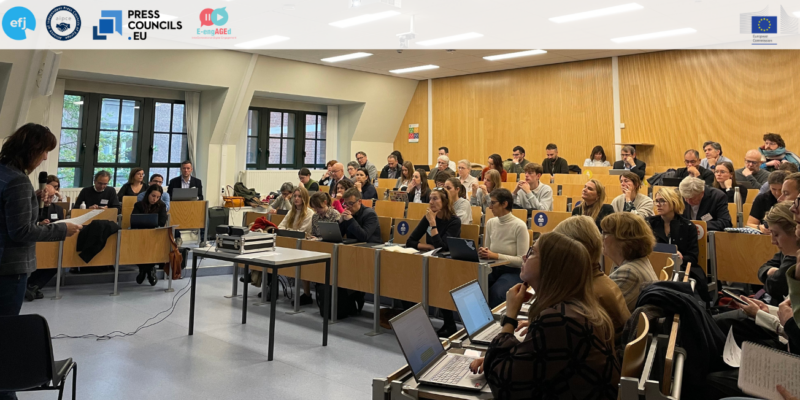
At last week’s EFJ (European Federation of Journalists) conference on self-regulation and regulation in the media sector, held in Brussels, the media community reached a consensus on the need for multistakeholder dialogue as countries begin implementing recent EU media laws.
The conference took place at the Université Libre de Bruxelles (ULB), bringing together over 90 participants—including media regulators, self-regulatory bodies, representatives of journalists and publishers, master’s journalism students from ULB, EU policymakers, researchers, and civil society representatives—for a day-long discussion on media regulation and its impact on journalists and citizens.
“This conference highlights the importance of self-regulatory systems, but also underscores that such systems can only function with the trust and engagement of the public, across all age groups,” said EFJ President Maja Sever. “To build—or rebuild—trust, we journalists must engage in dialogue with the audience and the public. Building dialogue and trust in media is particularly vital in the fight against disinformation.”
Student representatives raised concerns about the lack of diversity in newsrooms, stressing that media cannot effectively reach diverse audiences without actively representing marginalized groups. They also noted that young journalists are entering the labor market with growing awareness of the poor working conditions in many European countries.
A key topic of discussion was public trust in journalism and digital news media, with a focus on the ethical use of artificial intelligence (AI) in newsrooms. Participants agreed that while AI should be regulated, it should serve as a tool to help journalists become faster, more efficient, and more innovative—not as a replacement for human journalists. To that end, several media and press councils have introduced guidelines and codes of conduct related to AI. The debate also addressed the need for an ethical framework for individuals who influence news content.
“EFJ advocates for stricter AI regulations, particularly concerning copyright. This conference has demonstrated a sector-wide consensus: journalists and publishers need the EU to help protect intellectual property,” said EFJ Director Renate Schroeder. “The differences across Europe—in both practice and perception—underscore the urgent need to train AI systems in accordance with legal frameworks.”
Iva Nenadić, a researcher at the Centre for Media Pluralism and Media Freedom (CMPF), led a workshop on the Digital Services Act (DSA) and the European Media Freedom Act (EMFA) and their application to media and major online platforms. She emphasized the importance of addressing both EMFA and DSA together when discussing content moderation and highlighted systemic risks to media freedom referenced in Articles 14(4), 34, and 35 of the DSA. She also outlined the delicate balance between media content’s responsibility to offer pluralism for the public and maintaining economic viability for advertisers.
Senior journalists and media professionals pointed out that younger generations no longer read newspapers as previous generations did. “With the rise of digital media, we are facing a major trust crisis and a surge in disinformation,” said Adeline Hulin, Head of the Media and Information Literacy and Digital Competence unit at UNESCO. She presented UNESCO’s work on developing school curricula across Europe and its collaboration with youth organizations to promote media literacy.
“We used results from the Media Councils in the Digital Age project in our impact assessment. We need to open channels of communication and begin collaborating with self-regulators to establish self-regulatory systems in all EU countries. This will also require the support of regulators and will be a key follow-up priority,” said Anna Herold, Head of the Audiovisual and Media Policy Unit at the European Commission’s Directorate-General for Communications Networks, Content and Technology (DG CONNECT).
Frédéric Bokobza, Chair of the EMFA sub-group of the European Regulators Group for Audiovisual Media Services (ERGA), explained that the group’s priorities include collaboration with the media and journalists, and combating media market concentration. Herold added that media policy remains a priority for the European Commission as part of its broader efforts to strengthen the rule of law, democracy, and media innovation.
The conference concluded with an agreement among self-regulators and regulators to pursue a shared goal: cultivating a media landscape that upholds ethical and legal standards aligned with the rule of law and European democratic values.
“We are now entering a grey zone of new media legislation, particularly the EMFA and DSA,” said Carlos Aguilar Paredes, Vice President of ERGA. “Part of the process will be reaching a new level of collaboration between regulators and self-regulators.”
Drawing on the latest research on the evolving role of European self-regulatory bodies, ULB researcher Simone Benazzo led a workshop on strategic lawsuits against public participation (SLAPPs) and self-regulation. SLAPPs were presented as a form of pressure on the media, prompting participants to reflect on the new role self-regulatory bodies could play in defending press freedom.
In his closing remarks, ULB journalism master’s program coordinator David Domingo stressed the importance of having the right legislative tools to empower journalists and media organizations. While these tools are still evolving, he encouraged media professionals to focus on transparency and adherence to ethical standards to rebuild audience trust. He also emphasized the responsibility of media to reflect the diversity of society by opening newsrooms to people of all ages, genders, and cultural backgrounds.